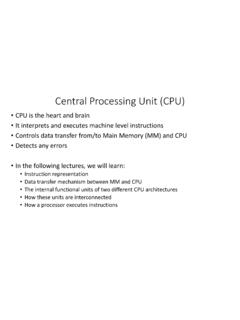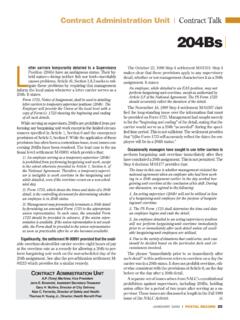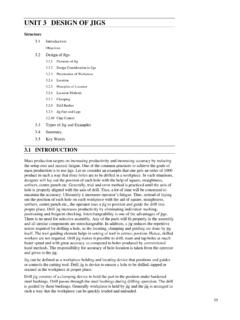Transcription of UNIT 2 THE ELECTROMAGNETIC SPECTRUM - NASA
1 Like expanding ripples in a pond after a pebblehas been tossed in, ELECTROMAGNETIC radiationtravels across space in the form of waves. Thesewaves travel at the speed of light 300,000 kilo-meters per second. Their wavelengths, the dis-tance from wave crest to wave crest, vary fromthousands of kilometers across (in the case ofthe longest radio waves) to fractions of ananometer, in the cases of the smallest x-raysand gamma rays. ELECTROMAGNETIC radiation has properties of bothwaves and particles. What we detect depends on themethod we use to study it. The beautiful colors thatappear in a soap film or in the dispersion of lightfrom a diamond are best described as waves. Thelight that strikes a solar cell to produce an electriccurrent is best described as a particle.
2 Whendescribed as particles, individual packets of electro-magnetic energy are called photons. The amount ofenergy a photon of light contains depends upon itswavelength. ELECTROMAGNETIC radiation with longSpace-Based AstronomyActivity Guide for Science, Mathematics, and Technology Education23 IntroductionContrary to popular belief, outer space is not empty space. It is filled with electro-magnetic radiation that crisscrosses the universe. This radiation comprises thespectrum of energy ranging from radio waves on one end to gamma rays on theother. It is called the ELECTROMAGNETIC SPECTRUM because this radiation is associat-ed with electric and magnetic fields that transfer energy as they travel throughspace. Because humans can see it, the most familiar part of the electromagneticspectrum is visible light red, orange, yellow, green, blue, and 2 THE ELECTROMAGNETIC SPECTRUM * Space Based 2/28/01 8:54 AM Page 23wavelengths contains little energy.
3 Electro-magnet-ic radiation with short wavelengths contains a greatamount of energy. Scientists name the different regions of the elec-tromagnetic SPECTRUM according to their wave-lengths. (See figure 1.) Radio waves have thelongest wavelengths, ranging from a few centime-ters from crest to crest to thousands of range from a few centimeters toabout cm. Infrared radiation falls between700 nanometers and cm. (Nano means onebillionth. Thus 700 nanometers is a distanceequal to 700 billionths or 7 x 10-7meter.) Visiblelight is a very narrow band of radiation rangingfrom 400 to 700 nanometers. For comparison, itwould take 50 visible light waves arranged end toend to span the thickness of a sheet of householdplastic wrap.
4 Below visible light is the slightlybroader band of ultraviolet light that lies between10 and 300 nanometers. X-rays follow ultravioletlight and diminish into the hundred-billionth ofa meter range. Gamma rays fall in the trillionth ofa meter wavelengths of x-rays and gamma rays are sotiny that scientists use another unit , the electronvolt, to describe them. This is the energy that anelectron gains when it falls through a potentialdifference, or voltage, of one volt. It works outthat one electron volt has a wavelength of centimeters. X-rays range from 100 elec-tron volts (100 eV) to thousands of electronvolts. Gamma rays range from thousands of elec-tron volts to billions of electron the ELECTROMAGNETIC SpectrumAll objects in space are very distant and difficultfor humans to visit.
5 Only the Moon has been vis-ited so far. Instead of visiting stars and planets,astronomers collect ELECTROMAGNETIC radiationfrom them using a variety of tools. Radio dishescapture radio signals from space. Big telescopeson Earth gather visible and infrared spacecraft have traveled to all theplanets in our solar system except Pluto and havelanded on two. No spacecraft has ever broughtback planetary material for study. They sendback all their information by radio everything astronomers have learnedabout the universe beyond Earth depends on theinformation contained in the electromagneticradiation that has traveled to Earth. For example,when a star explodes as in a supernova, it emitsenergy in all wavelengths of the electromagneticspectrum.
6 The most famous supernova is thestellar explosion that became visible in 1054 andproduced the Crab Nebula. ElectromagneticNational Aeronautics and Space Administration24 These two views of the constellation Orion dramatically illustrate the differ-ence between what we are able to detect in visible light from Earth s surfaceand what is detectable in infrared light to a spacecraft in Earth orbit. PhotoCredits: Akira Fujii visible light image; Infrared Astronomical Satellite infrared image.* Space Based 2/28/01 8:54 AM Page 24radiation from radio to gamma rays has beendetected from this object, and each section of thespectrum tells a different piece of the most of history, humans used only visiblelight to explore the skies. With basic tools andthe human eye, we developed sophisticatedmethods of time keeping and were invented in the 17th then mapped the sky in greaterdetail still with visible light.
7 They learnedabout the temperature, constituents, distribu-tion, and the motions of the 20th century, scientists began to explore theother regions of the SPECTRUM . Each region provid-ed new evidence about the universe. Radio wavestell scientists about many things: the distribution ofgases in our Milky Way Galaxy, the power in thegreat jets of material spewing from the centers ofsome other galaxies, and details about magneticfields in space. The first radio astronomers unex-pectedly found cool hydrogen gas distributedthroughout the Milky Way. Hydrogen atoms arethe building blocks for all matter. The remnantradiation from the Big Bang, the beginning of theuniverse, shows up in the microwave SPECTRUM . Infrared studies (also radio studies) tell us aboutmolecules in space.
8 For example, an infraredsearch reveals huge clouds of formaldehyde inspace, each more than a million times more mas-sive than the Sun. Some ultraviolet light comesfrom powerful galaxies very far away. Astronomershave yet to understand the highly energeticengines in the centers of these strange objects. Ultraviolet light studies have mapped the hot gasnear our Sun (within about 50 light years). Thehigh energy end of the SPECTRUM x-rays andgamma rays provide scientists with informationabout processes they cannot reproduce here onEarth because they lack the required physicists use strange stars and galaxies as alaboratory. These objects are pulsars, neutron stars,black holes, and active galaxies. Their study helpsscientists better understand the behavior of matterat extremely high densities and temperatures in thepresence of intense electric and magnetic region of the ELECTROMAGNETIC SPECTRUM pro-vides a piece of the puzzle.
9 Using more than oneregion of the ELECTROMAGNETIC SPECTRUM at a timegives scientists a more complete picture. Forexample, relatively cool objects, such as star-form-ing clouds of gas and dust, show up best in theradio and infrared spectral region. Hotter objects,such as stars, emit most of their energy at visibleand ultraviolet wavelengths. The most energeticobjects, such as supernova explosions, radiateintensely in the x-ray and gamma ray are two main techniques for analyzingstarlight. One is called spectroscopy and theother photometry. Spectroscopy spreads out thedifferent wavelengths of light into a SPECTRUM forstudy. Photometry measures the quantity of lightin specific wavelengths or by combining allSpace-Based AstronomyActivity Guide for Science, Mathematics, and Technology Education25 Figure 1: ELECTROMAGNETIC SPECTRUM * Space Based 2/28/01 8:54 AM Page 25wavelengths.
10 Astronomers use many filters intheir work. Filters help astronomers analyze par-ticular components of the SPECTRUM . For exam-ple, a red filter blocks out all visible light wave-lengths except those that fall around 600nanometers (it lets through red light).Unfortunately for astronomical research, Earth satmosphere acts as a filter to block most wave-lengths in the ELECTROMAGNETIC SPECTRUM . (SeeUnit 1.) Only small portions of the spectrumactually reach the surface. (See figure 2.) Morepieces of the puzzle are gathered by puttingobservatories at high altitudes (on mountaintops) where the air is thin and dry, and by flyinginstruments on planes and balloons. By far thebest viewing location is outer Goals To investigate the visible light SPECTRUM .















